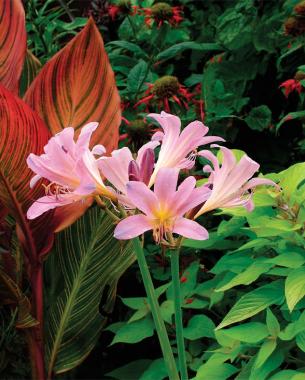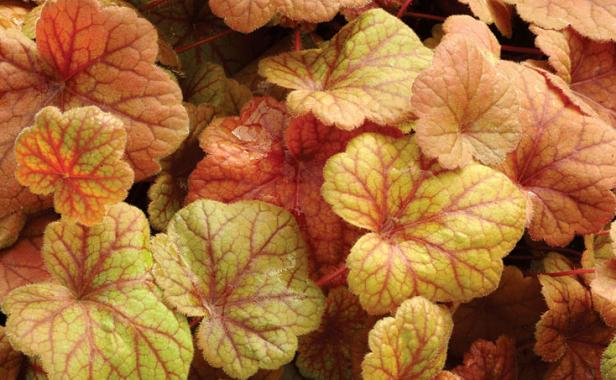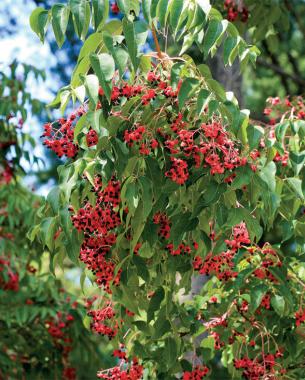
There is no disputing the beauty of fall. Gardens slowly become infused with beautiful shades of red, yellow, and orange signaling the end of another season. There is a color, however, just one notch over from red on the color wheel, that can be a gardener’s best friend in fall: red’s rosy relative—pink.
For many, pink evokes a range of emotions. During the height of summer, this unassuming blushlike hue can be overshadowed by the riot of other colors. But later, in fall, pink can become a standout focal point. That’s because pink is a color you just don’t expect in September, October, or November, so your eye is instantly drawn in its direction. This may seem like an unlikely color to add to the autumnal mix, but it blends in beautifully with traditional fall favorites while giving any vignette a strong visual punch. Here are some of my favorite pink plants for fall.
Puts all other mums to shame

Photo/Illustration: Nancy Ondra
‘Sheffield Pink’ mum (Chrysanthemum ‘Sheffield Pink’)
USDA Hardiness Zones: 3 to 9
Size: 2 to 3 feet tall and wide
Conditions: Full sun; well-drained soil
‘Sheffield Pink’ mum has stood the test of time. Sometimes listed as just ‘Sheffield’, ‘Single Apricot’, or ‘Hillside Pink Sheffield’, this hardy mum has lovely, soft green foliage and dark burgundy stems in spring and summer. In early fall, it sports cute pink buds, which eventually detonate into 3-inch-wide, peachy pink blooms in midfall. The perfect companions are ‘Little Joe’ Joe Pye weed (Eutrochium dubium ‘Little Joe’, Zones 3–9) or a purple-blooming aster (Symphyotrichum oblongifolium cv., Zones 3–8), each of which mixes well with the floral display of ‘Sheffield Pink’. To keep this mum looking tidy, cut back the stems several inches after the first flush of growth to encourage a compact habit and to increase flowering.
Thrives in unlikely spots

Photo/Illustration: courtesy of Plant Introductions
‘Pink Frost’ small anise tree (Illicium floridanum ‘Pink Frost’)
Zones: 6 to 9
Size: 6 to 10 feet tall and wide
Conditions: Partial shade; moist, well-drained soil
Shade loving and adaptable to wet sites, this compact evergreen shrub is fairly new to the gardening world. ‘Pink Frost’ small anise tree has pencil-thin white variegation around the edge of each leaf and small, deep ruby red flowers that appear in midspring. Its four-season character is highlighted with the advent of cold weather, when the green leaves develop beautiful pink hues. Another noteworthy trait of ‘Pink Frost’ small anise tree is its sturdy stems, which hold the foliage upright even through moderate snowfalls. Also, deer tend to avoid this plant. Due to its similar conditional preferences, ‘Ruby Spice’ summersweet (Clethra alnifolia ‘Ruby Spice’, Zones 3–9) makes a great cohort.
Looks like it is covered in bubblegum

Photo/Illustration: Bill Johnson
‘Welch’s Pink’ American beautyberry (Callicarpa americana ‘Welch’s Pink’)
Zones: 5 to 9
Size: 6 feet tall and 5 feet wide
Conditions: Full sun to partial shade; moist, well-drained soil
As other deciduous shrubs start to fade with cooler temperatures, American beautyberry hits its stride. A curveball from the common purple- or white-fruited cultivars is ‘Welch’s Pink’. Gobs of cotton candy–colored berries cling to each stem of this shrub from early to late fall. The fruit color fades in full sun, so give this shrub some afternoon shade. ‘Welch’s Pink’ is best placed among other large shrubs, like oakleaf hydrangea (Hydrangea quercifolia and cvs., Zones 5–9), which help support its fruit-laden stems. American beautyberry sports sprays of bright green foliage in spring and summer and likes to be pruned back to 6 inches in late winter or early spring.
Provides a transparent cloud of color

Photo/Illustration: Nancy Ondra
Pink muhly grass (Muhlenbergia capillaris )
Zones: 6 to 10
Size: 3 to 4 feet tall and wide
Conditions: Full sun; well-drained soil
Striking en masse, this North American native continues to rise in popularity—and for good reason. Although pink muhly grass can be rather drab looking during the growing season, its inflorescences form soft clouds of pink in fall. This plant falls into the category of “worth the wait.” To ensure winter hardiness, plant this ornamental grass in spring so that it has time to get fully established. Companions abound, but my favorite is any long-blooming shrub rose with a complementary bloom hue, such as Pink Meidiland® rose (Rosa ‘Meipoque’, Zones 4–9).
Boasts out-of-this-world coloring

Photo/Illustration: Bill Johnson
‘Neon’ sedum (Sedum spectabile ‘Neon’)
Zones: 3 to 9
Size: 18 inches tall and 12 to 18 inches wide
Conditions: Full sun; well-drained soil
If you type the name of this plant into an online search engine, you might think the photo results have been doctored. This is truly one of the most eye-catching, neon pink plants you can get for late-season masses of shocking color. Because you don’t want any surrounding neighbors to compete with its unique blooms, I like surrounding ‘Neon’ sedum with perennials that complement its foliage during the growing season, like ‘Elijah Blue’ blue fescue (Festuca glauca ‘Elijah Blue’, Zones 4–8) and ‘Walker’s Low’ catmint (Nepeta racemosa ‘Walkers Low’, Zones 4–8). This sedum is a rock-solid hardy perennial in almost every region of the country. To encourage stout stalks and a later bloom time, I like to cut it back by half early in the growing season.
Not an ordinary ho-hum lily

Photo/Illustration: Nancy Ondra
Surprise lily (Lycoris squamigera )
Zones: 6 to 11
Size: 18 to 24 inches tall and wide
Conditions: Full sun to partial shade; fertile, well-drained soil
True to its name, surprise lily jumps from the ground sometime between late summer and midfall. Lycoris squamigera is a true pink, while L. radiata—which you might also see in nurseries—is a red that eventually fades to pink. Morning sun and light afternoon shade will lead to the longest-lasting flowers. This plant has no foliage to speak of, and its beautiful blossoms are perched atop long stems. To hide those bare legs, I like to pair surprise lily with billowy ground covers, like ‘Angelina’ sedum (Sedum rupestre ‘Angelina’, Zones 6–9) or ajuga (Ajuga spp. and cvs., Zones 3–9).
Keeps getting better as the temperature drops

Photo/Illustration: courtesy of Terra Nova Nurseries
‘Electra’ heuchera (Heuchera ‘Electra’)
Zones: 4 to 9
Size: 12 to 18 inches tall and wide
Conditions: Partial shade; moist, well-drained soil
It’s true: New heucheras are a dime a dozen. We’ve all experimented with a litany of different variations of this wonderful little plant, only to be disappointed. But ‘Electra’ doesn’t disappoint. As the weather turns colder, pink radiates out of the midrib of each leaf followed by a full transition to pinky hues. This hybrid is part Heuchera villosa, which is native to the rocky slopes of Appalachia. This gives ‘Electra’ toughness and more heat tolerance than its wimpier cousins. There’s not much that doesn’t complement heucheras, but bold green foliage—possibly from lady’s mantle (Alchemilla mollis , Zones 4–7) or ‘Blue Cadet’ hosta (Hosta ‘Blue Cadet’, Zones 3–9)—will offset the leaf color of ‘Electra’ well.
Pink can help tone things down, too
There’s no denying that fall can be a riot of color. During this time of year, the garden explodes with hot hues. Aside from acting as a focal point, pink can also help tone down this searing scene. Because pink is a tint of red (red + white), it blends in with other hot colors (yellow and orange) but takes the level of intensity down a notch. This principle can be used anytime you want to tone things down a bit: to isolate an area of the garden that seems too riotous in the color department or to add a plant that possesses a tint of any of the colors that are in play. This guarantees that this spot in the garden will no longer burn your retinas but will still have a blended composition.
Adds a little bit of exotic flair

Photo/Illustration: KENPEI/courtesy of commons.wikimedia.org
Pink velvet banana (Musa velutina)
Zones: 7 to 11
Size: Up to 5 feet tall and wide
Conditions: Full sun; moist, fertile, well-drained soil
If you plant this beauty in your garden, you’ll possess an unrivaled conversation piece. Pink velvet banana is a hardy plant that forms a multistemmed colony. Its broad foliage resembles that of cannas during spring and early summer. To highlight its bold form, I like to pair it with fine-textured Arkansas bluestar (Amsonia hubrichtii, Zones 5–8). From late summer through late fall, this banana gets large, highlighter pink flowers, which transform into finger-size fruit covered in vibrant pink velvet. For those living in the cool end of its zones, you may want to mulch the plant heavily in winter until it gets fully established to ensure its hardiness.
A tree unusual for its unending interest

Photo/Illustration: Bill Johnson
Korean sweetheart tree (Euscaphis japonica)
Zones: 6 to 9
Size: Up to 20 feet tall and 15 feet wide
Conditions: Full sun to partial shade; moist, fertile soil
This small tree is anything but commonplace, but if more people knew how wonderful it is, it would surely gain in popularity. Its dark, emerald green leaves and rosy pink fall seed heads make Korean sweetheart tree a late-season star. As fall approaches, showy heart-shaped capsules burst open to reveal shiny, bluish black seeds, which persist for several months. Although spectacular in fall, this tree offers year-round appeal: In late spring, attractive sprays of yellow flowers appear; in winter, the mocha-colored bark with pronounced white stripes is stunning. Because every part of this tree is beautiful, you won’t want to obscure even its trunk, so flank it with medium-size ornamental grasses, like ‘Morning Light’ miscanthus (Miscanthus sinensis* ‘Morning Light’, Zones 4–9).
*Invasive in some regions
Birds love it, but deer don’t

Photo/Illustration: courtesy of Forest Farm
‘Pink Lady’ winterberry euonymus (Euonymus bungeanus ‘Pink Lady’)
Zones: 4 to 8
Size: Up to 20 feet tall and wide
Conditions: Full sun; well-drained soil
An uncommon plant in most gardens, this tree-form euonymus sports an amazing autumn display. Best reserved for the back of a border, ‘Pink Lady’ winterberry euonymus is rounded with a pendulous branching habit. Unusual pink seed capsules burst open in fall to reveal reddish orange seeds. These late-season fruit are a favorite of many birds, but thankfully, deer tend to leave the entire plant alone. Plants with an informal feel that shine in late spring or summer (when ‘Pink Lady’ isn’t in its full glory) are an excellent match; my pick is panicle hydrangea (Hydrangea paniculata and cvs., Zones 4–8).
Fine Gardening Recommended Products

The Nature of Oaks: The Rich Ecology of Our Most Essential Native Trees
Fine Gardening receives a commission for items purchased through links on this site, including Amazon Associates and other affiliate advertising programs.

Gardener's Supply Company Summerweight Fabric Plant Cover
Fine Gardening receives a commission for items purchased through links on this site, including Amazon Associates and other affiliate advertising programs.

ARS Telescoping Long Reach Pruner
Fine Gardening receives a commission for items purchased through links on this site, including Amazon Associates and other affiliate advertising programs.



















Comments
Great article Andy! Where do you learn about Euscaphis japonica? JC Raulston Arboretum?
I'm always pleasantly surprised to find any mention of a plant in an FG publication that includes zones 10 or 11 in its designation. I know that it occurs much more often than I think it does, but would love to see some real articles about gardening in the frostless wasteland of the West. BTW, heucheras are growing like they don't know any better right here in my 10b front yard. Mums end at zone 9??? Please don't tell anybody else in Southern California that - we might have to stop growing them like wildflowers.
Log in or create an account to post a comment.
Sign up Log in